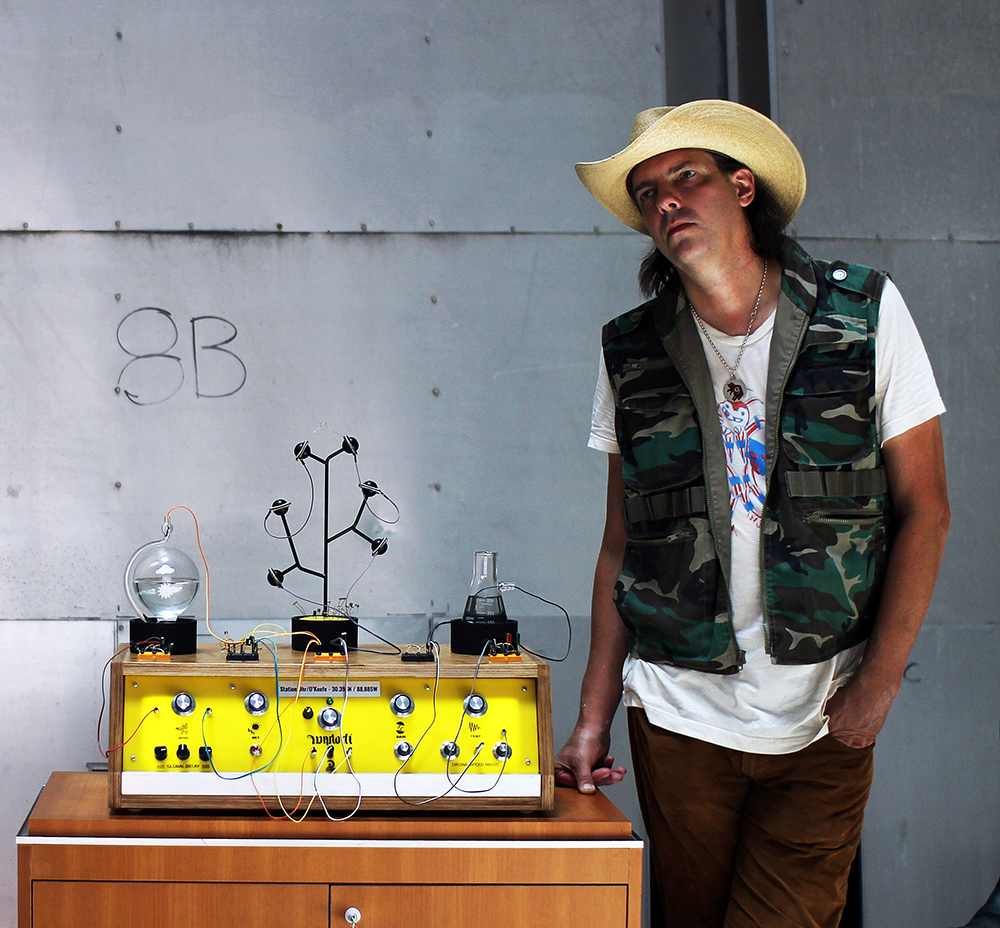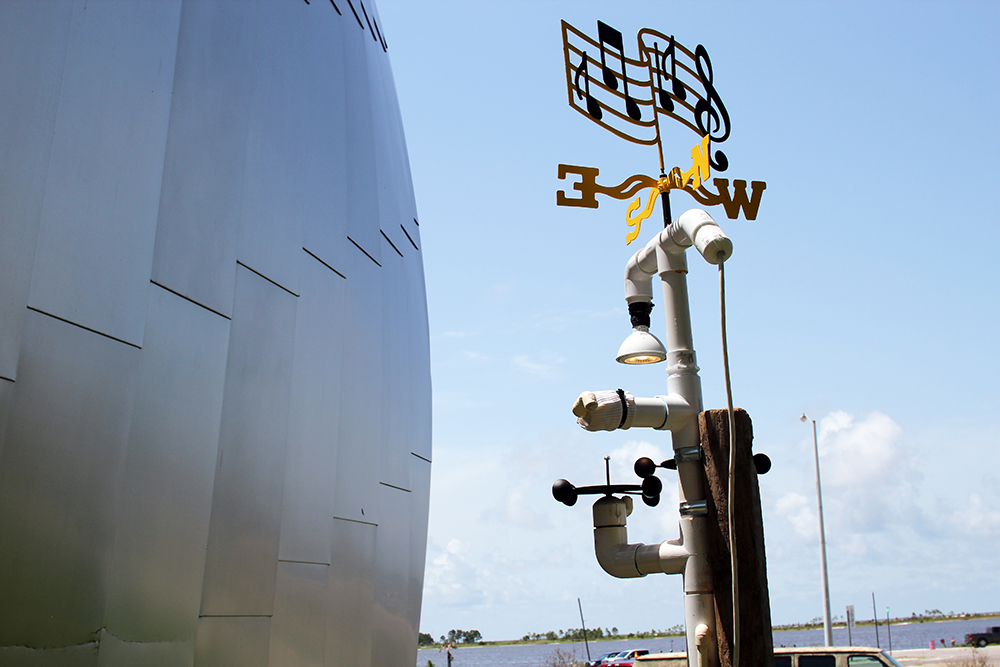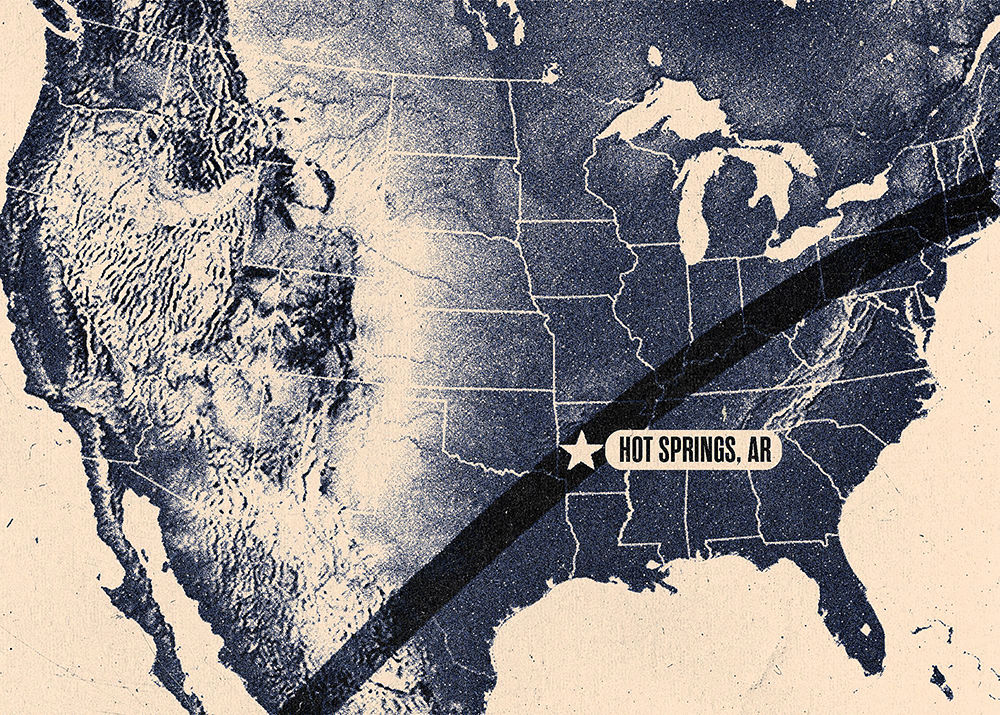Throughout the day on Monday, April 8th, the moon’s vast shadow, 100 miles across, will pass over the face of the Earth like some great mother ship, blocking light in a creeping path from the Pacific Ocean’s Cook Islands to a point in the Atlantic Ocean some 200 leagues west of France. Those under the hundred-mile-wide band of the shadow will experience a total eclipse of the sun, wherein the apparent size of the lunar disc will exactly match and obscure the sun’s disc, in one of the great coincidences of orbs and orbits in our cosmos, dimming the day as it swings into place and finally blocking all direct sunlight for a few minutes. Then the moon will move away and the day will enjoy a second dawn.
“It’s like a fast-forward sunset and sunrise,” says Quintron, the New Orleans-based musician and inventor who created Weather Warlock, an analog synthesizer and audio processor triggered by signals from an array of wind, humidity, sound, and light sensors. The eclipse, with its stark contrasts, is a time for his creation to shine. He’s noted the Weather Warlock’s sensitivity to the changing light of dusk or dawn before, but the eclipse, he says, is “approximately 10 times as fast.”


The Ecliptic Festival
Like thousands of others, Quintron will be in Hot Springs, Arkansas, when it all goes down. The classic resort town lies directly in the path of totality, as does much of the Natural State. In Hot Springs, the eclipse’s timing corresponds to a time-honored tradition, the Valley of the Vapors music festival, now in its 20th year. This year’s version will be unique, as it’s being co-produced by Atlas Obscura, a company specializing in unorthodox travel packages. Together, they’re calling this hybrid celebration the Ecliptic Festival, and it’s huge.
From April 5th to April 8th, up to 4,000 attendees will gather at Hot Springs’ Cedar Glades Park for musical performances and events with artists, philosophers, astronomers, and other speakers — along with ringside seats to the spectacle of a full solar eclipse. These astronomical pilgrims will be staying in glamping tents, camping on their own, or booking other accommodations (quickly filling up) in Hot Springs or nearby Little Rock.
The startlingly eclectic lineup includes performers like Allah-Las, Blonde Redhead, Deerhoof, and Shannon and the Clams; mythologist and storyteller John Bucher; theoretical physicist Kelly Reidy; and author and astronomer Rebecca Boyle, who will conduct a guided stargazing session. Of course, the first three days of the bash will be much like any other festival, albeit with more telescopes, as the moon and sun won’t yet be engaged in their cosmic pas de deux. Then on Monday, the music will take a left turn.
When the moon begins its creep across the face of the sun, experimental harpist Mary Lattimore will help usher in the darkness. Though faster than a sunset, the dimming of the day occurs over more than an hour and 20 minutes. Halfway through it, music on the main stage will stop and the headlining “artist” leading up to and through the total occultation of the sun will be a robot, tuned in to the sounds of nature.

All Hail the Weather Warlock
Although Quintron sometimes assembles a band that’s billed as Weather Warlock, at the heart of it is the machine he designed some 10 years ago, a device that “uses sun, wind, rain, and temperature to control a monster analog synth designed by Quintronics,” as his website explains. Multiple sensors convert changes in wind speed, barometric pressure, rainfall, and light into voltage and thence synthesizer tones. When the weather or light is shifting, no band is necessary: The device creates fascinating tonal paintings entirely on its own, worth recording and releasing.
“During Hurricane Ida,” says Quintron, “we knew a weather event was coming and I knew it was going to get really nuts. So I tuned up all the sensors, dialed it in, and then just set it to record as long as the power stayed on. And it stayed on quite a while, pretty deep into extreme hurricane winds and rainfall. And that became the record, PEOPLE = ANTS.”
Well before Ida, of course, Quintron and his device were active during the 2017 total solar eclipse, perched on the roof of Third Man Records in Nashville, the audio of which was later released as the record, Occulting the Sun. But Quintron’s approach has evolved somewhat since then.
“I’m going to have mics set up in the area too,” says Quintron of his Hot Springs setup. “My whole microphone system and the electronic filtration of that source has now come to be called the Wildlife Organ, which is just a series of all-weather microphones at different elevations in the wilderness, capturing the critters. Because how the animals and insects and birds respond to an eclipse is kind of the most mind-blowing thing about it.”
As day turns to night, birds and bees stop their activity and the crickets come out to sing. While the Weather Warlock’s mics and sensors will in fact be running throughout the festival, “like a little weather station that people can visit, going on 24/7 during the entire fest,” he says, the approach to and immersion in totality will make for the most dramatic effects from Quintron’s device. “This is the Super Bowl Sunday for Weather Warlock, so during totality it’s only going to be Weather Warlock playing. I’m not going to mess with it too much. I just want to experience this machine that I built, reacting to the sky.”
Accordingly, he hopes the festival attendees will respect the moment. “I begged [the festival organizers] to please let me be the only sound-generating human during the actual eclipse,” he says, and his wish has come true, assuming festival partiers cooperate and simply listen. “I just want to let the lords of the skies and Mother Earth do their thing. I don’t want to comment or interact or join in because it’s such a rare weather event.”
During totality, from roughly 1:49 to 1:53 p.m. in Hot Springs, the sun’s disc will be blocked, but it won’t be entirely dark. Rather, an eerie twilight will set in, and stars will appear. As in 2017, Venus and Jupiter (and other less visible planets) will appear on either side of the occulted sun. For close to four minutes, observers will be able to remove their protective sun-viewing glasses (the only time it’s safe to do so) and marvel at how small we are. People = ants, indeed.
And then, gradually, Weather Warlock will surrender its command of the festival, giving way to what many, including Quintron, are most keenly anticipating: an appearance by the acolytes of Sun Ra himself.

The Sun Ra Arkestra
Booking the Sun Ra Arkestra on the day of the eclipse was an inspired choice by Atlas Obscura and Valley of the Vapors, and not just because it’s arguably the longest-running, continuously operated jazz ensemble in the world today. Sun Ra, born Herman Blount in Birmingham, Alabama, transformed himself and his music by putting the transcendent possibilities of cosmic bodies — the moon, Saturn, the stars, the sun — at the heart of his creativity. Changing his name to honor the Egyptian god Ra in the mid-Fifties, he never looked back, assembling an ever-shifting big band that paired increasingly free jazz with more disciplined compositions and even the sounds of exotica, as they chanted, “We travel the spaceways/From planet to planet …”
Though its leader passed away in 1993, the Arkestra — pairing “orchestra” with an allusion to a wandering ark — sailed on, led today by its oldest surviving member, Marshall Allen, who joined the group in the late ’50s. And Allen, now 99, has kept the Arkestra’s guiding aesthetic in place, from the bold, colorful costumes to the eclectic mix of big band swing tunes (Fletcher Henderson is a favorite), chanted songs of space, and free improvisation.
Tyler Mitchell, who first played with Sun Ra in the ’80s before rejoining the Arkestra in 2010, still marvels at the saxophonist’s vigor. “Marshall’s amazing,” he says. “He still moves around and is in good shape, man! I admire him. He’s just such a great example to mankind, to people. Not just to musicians.”
Quintron, for his part, is especially excited that the Arkestra will immediately follow him. “I’ll be taking the baton between the harpist, Mary Lattimore, and Sun Ra. I’ve been given the go-ahead to overlap and kind of join those two artists.” And he couldn’t be more pleased. “Sun Ra,” says Quintron, “is on my personal Mount Rushmore of how to think about music and how to approach music.” Having said that, neither Quintron nor the Arkestra members themselves know exactly what to expect when they take the stage.
Recalling the Arkestra’s performance at Atlas Obscura’s 2017 eclipse event in Oregon, Mitchell explains, “The last time we did it, we just followed Marshall’s cues. Neither Sun Ra or Marshall tell you what they’re going to play. Sometimes Marshall is known to just get up and have us play a space chord, where everybody just blows a note, and he directs you with his hand. And just the different textures of the space chords would be the song.”
But things could be more arranged. “We also have what we call stomps,” says Mitchell, “like the old Fletcher Henderson stuff. Marshall covers all the different styles in jazz when we do a concert. And if a song’s too nice and neat and clean, and all too perfect, he’ll come in and just mess it all up. You don’t want it to be too perfect. He likes to have that chaos.”
And so, as the sunlight gradually reemerges, expect the unexpected, but know that the Sun Ra Arkestra, having such songs in their repertoire as “When Sun Comes Out,” “Solar Differentials,” “Dancing Shadows,” and “Satellites Are Spinning” are well-prepared to capture the moment.

Lighting Out for the Graze Zone
For Memphians who want to experience totality, Hot Springs is arguably the most musical destination on April 8th, but there are other options, from low-key gatherings to camping on your own. The zone of complete occultation stretches from the southwest to the northeast of the state, with many planned events and over two dozen state parks in that area. The Crystal Garden in Mt. Ida, Arkansas, for example, will have camping and acoustic music amidst the largest quartz crystal deposit in the world, nestled in the Ouachita National Forest. The University of Arkansas in Little Rock will have a family-friendly event, and Arkansas State University in Jonesboro will participate in the Nationwide Eclipse Ballooning Project, sponsored by NASA, releasing dozens of weather balloons laden with scientific instruments to record atmospheric changes during the eclipse. Meanwhile, the website ozarktotaleclipse.com lists several smaller-scale celebrations in the Ozark foothills, all in the path of totality.
As the site ar-eclipse.info notes, some prefer to be on the margins of that path, in what’s called “the graze zone.” In some ways, being on the borders of totality’s path can make the eclipse even more striking. As described by NASA, “An observer positioned here will witness a solar crescent which is fragmented into a series of bright beads and short segments. … These beading phenomena are caused by the appearance of photospheric rays which alternately pass through deep lunar valleys and hide behind high mountain peaks as the moon’s irregular limb grazes the edge of the sun’s disk.” Properly viewed with protective glasses, this near-total eclipse ringed with beams and flares of light can be spellbinding, especially for astrophotography buffs.
Closer to home, outside the path of totality, the eclipse will still be impressive. Indeed, the village of Wilson, less than an hour away, will be especially active. Their Crawfish Festival takes place through the day of April 6th, giving way to live music that evening and ultimately an eclipse-viewing gathering two days later, when the sun’s disc will be 99.38 percent blocked at its peak. (Protective glasses must be worn the entire time when observing the sun.)
Just down the road in Dyess, Arkansas State University’s KASU radio station will host the Arkansas Roots Music Festival in front of the Johnny Cash Boyhood Home on the 6th, with El Dorado-native Jason D. Williams headlining, plus a “lunch and learn” with NASA scientist Dr. Les Johnson on the 7th, and the option to park campers near the historic home for the following day’s astronomical event.
And finally, lest one forget the wide-ranging impact the eclipse will have on all of nature, one NASA initiative may persuade you to eschew the music and hoopla and simply listen. Known as the Eclipse Soundscapes Project, it puts the invisible at the center of the celestial experience, encouraging people from all walks of life to document the stark changes in animal behavior when all goes dark. As noted on the NASA website, the eclipse offers “the perfect opportunity for a large-scale citizen science project.” Volunteers will be asked to use a low-cost audio recording device to capture nature’s sounds during the eclipse, or to write down their multisensory observations for submission to the project website.
“I’m so glad that they’re doing that,” says Quintron of NASA’s Eclipse Soundscapes Project. “I’m very happy that I won’t be in a big city, but in a forest. And making recordings out in the field, where there is not a large amount of human influence, is really important. We need recordings of what the critters and the birds and the insects are doing during this event because it’s really remarkable. They’re not reading on the news that the eclipse is coming. They’re purely reacting to it. And in a similar way, I just really want to draw people’s attention to the physical world that they live in, in whatever way I can.”
